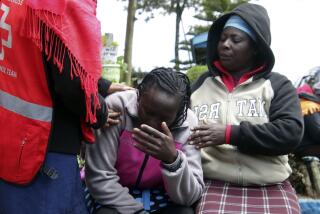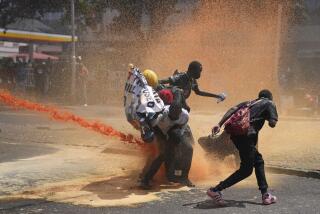Dormitory Fire Kills 58 Teens in Kenya
JOHANNESBURG, South Africa — Fire swept through a crowded boarding school dormitory in rural Kenya on Monday, burning 58 teenage boys to death and seriously injuring 28 others.
The cause of the blaze, which started about 1:40 a.m. in the main boys’ dormitory at the Kyanguli secondary school, was not immediately known. But Julius Narangui, the local police chief in Machakos, a farming town about 30 miles southeast of Nairobi, the capital, said there was reason to suspect arson.
One of two doors to the dormitory was locked; iron bars and wire mesh on the windows prevented many boys from escaping.
The tragedy added to concerns about Kenya’s poor fire safety standards and emergency procedures for schools and other public buildings. Twenty-five girls died in a still unexplained blaze at a school in Bombolulu near the coastal city of Mombasa in 1998.
Earlier this month in West Africa, 23 schoolgirls were burned alive in a locked dormitory in Nigeria after a kerosene lantern overturned.
Fire drills are rare in Kenyan schools, where the practice of locking students in at night is common. At Bombolulu, the girls were reportedly confined to prevent them from sneaking out to meet boys. Chained doors and barred windows also obstructed the efforts of villagers in northern Nigeria to save the girls who perished there.
Rising crime in Kenya has encouraged school officials to keep the students locked in at night.
Education officials said that 160 boys between the ages of 15 and 19 had been sleeping in the Machakos dormitory. Police said that some of the youths managed to scramble to safety through the roof, which had collapsed. The fire spread quickly.
“First the fumes engulfed them, and then the roof caved in,” district police commissioner Hussein Dado told reporters.
Firefighters, who have a nationwide reputation for inefficiency and lack of equipment, were not summoned, police said. Instead, heavy rain and police using the coed school’s garden hoses eventually extinguished the fire.
Relatives and neighbors rushed to the gutted single-story building. Crowds stood behind police cordons, staring in disbelief as emergency workers picked through scorched debris beside stacks of charred corpses, searching for clues.
Police said they were called to the school after being told that students had gone on a rampage. Francis Ngunga, an English teacher, told reporters at the scene that a boy had left the dormitory about 1:30 a.m. to report to an adult supervisor that some kind of liquid was spread across the floor. When the two returned, they found the door locked and a fire blazing inside, Ngunga said.
Students told local journalists that some fellow students had taken jerrycans of gasoline to the school the evening before the blaze. Their motive was unclear. Police said that school officials reported smelling gasoline in the dormitory Sunday but that an investigation had found nothing.
There were also unconfirmed reports that some students had been involved in a brawl before the incident, and one boy told journalists that a dispute between the administration and the students might have led to the calamity.
Police and government officials said they were pursuing all leads.
Kenyan President Daniel Arap Moi visited the site. “This is a ghastly incident that has never been seen before in these parts,” Moi said. “The doors should have been open. These children could have escaped easily.”
At least nine survivors were taken to Nairobi’s Kenyatta Hospital.
Mary Mwanza, a Machakos farmer, wept uncontrollably outside the intensive care unit as she related how her 19-year-old son, Bila, had happily enrolled at the school last month. It was the first time mother and son had been separated.
“He’s burned very badly, and I am shocked,” said Mwanza, 48, a mother of eight.
Clasping her head in both hands, Lesa Nthambi said her 16-year-old son, Sylvester Mutua, was so seriously burned that she had decided to “leave him to God.”
Dr. Hosea Waweru, the hospital’s director, said most of the patients had been burned over at least 60% of their bodies and had inhaled hot fumes. Many of the dead boys were burned beyond recognition, police said.
Boarding schools are common throughout Kenya. Many parents opt for this kind of education because discipline and academic achievement usually at the facilities are better than at other institutions. Kyanguli was no exception.
“This is the best school in the area,” said Elizabeth Mwasia, a primary school teacher whose son Nicholas, 18, was receiving treatment for his burns at Kenyatta. “I had never had any problem with the school or heard anyone complain about it.”
Local mental health specialists said the tragedy would only serve to torment an already demoralized nation, beaten down by economic and social hardships.
“In many ways, kids are just going to wait and worry about another catastrophe taking place,” said Frank Njenga, a respected psychiatrist based in Nairobi. “And what about the parents? They won’t be able to get a night’s sleep.”
“It does frighten me,” said one Nairobi mother who has two children, ages 14 and 17, in boarding school and requested that her name not be used. “You get worried as a parent. You just hope things will be OK.”
*
Samuel Hinga Mwangi and Bertha Omany-Odeny of The Times’ Nairobi Bureau contributed to this report.
More to Read
Sign up for Essential California
The most important California stories and recommendations in your inbox every morning.
You may occasionally receive promotional content from the Los Angeles Times.











